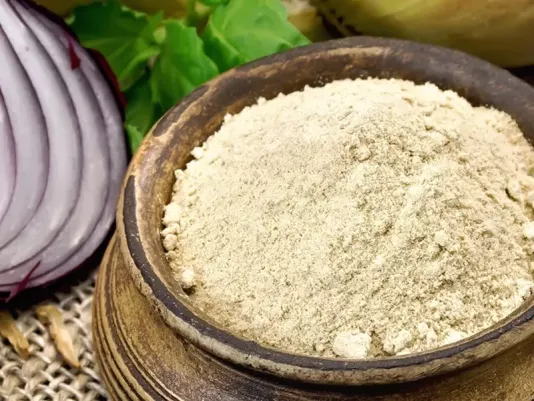Dried Onion

Dried onion is a seasoning widely used in world cuisine thanks to its versatility, convenience, and long shelf life. It is made by dehydrating fresh onion, which allows it to preserve its natural aroma and nutrients. I have often found that dried onion can replace fresh onion in dishes when there is a need to save time without losing rich flavor. It is available in flakes, granules, or powder, making it convenient for various types of cooking – from soups and sauces to marinades, appetizers, and homemade baked goods. It is especially practical to have dried onion on hand when fresh is not available, as it requires no cleaning, dissolves quickly in liquids, and adds pleasant flavor and aroma to meals.
Recipes with Dried Onion
Nutritional Value and Benefits of Dried Onion
Dried onion retains most of the beneficial compounds of fresh onion while offering additional advantages in terms of convenience. It contains B vitamins as well as vitamin C, part of which remains even after thermal processing, supporting the immune system. I have repeatedly used dried onion in everyday cooking and noticed that it not only simplifies the process but also makes dishes richer in flavor without extra salt or artificial enhancers. It also contains natural antioxidants that help protect the body’s cells from harmful free radicals. In addition, dried onion provides dietary fiber, which supports digestion. Thanks to its reduced moisture, it has a more concentrated taste than fresh onion, which means smaller amounts are enough to achieve the desired effect. I’ve noticed that dried onion pairs well with many protein-based foods – meat, poultry, fish – making dishes more flavorful and nutritious. Because of its low calorie content, it is also suitable for diet-friendly meals, helping diversify dishes without compromising health. All this makes dried onion an important kitchen staple, combining practicality with health benefits.
Culinary Uses of Dried Onion
Dried onion stands out for its versatility and ability to enhance the flavor of a wide range of dishes. I often add it to soups and broths, since it quickly dissolves in hot liquid and delivers a strong aroma without long sautéing. In sauces and marinades, dried onion performs even better: granules release their flavor slowly and add depth that is difficult to achieve with other spices. Onion powder is especially convenient, as it blends evenly with spice mixes and balances the flavor of any dish. I’ve also noticed that dried onion works well in homemade baked goods, such as breads or savory rolls, giving them a pleasant piquancy. It is often included in seasoning blends for meat – together with garlic, paprika, or black pepper – creating a universal base for rubs. In salads and appetizers, onion flakes add texture and a pleasant crunch. Even simple dishes – from omelets to mashed potatoes – become more varied thanks to dried onion. This multifunctionality explains why dried onion is considered one of the most practical spices that should always be in the kitchen.
Nutritional Benefits for the Body
Dried onion preserves a significant part of the nutrients found in fresh onion, although some concentrations slightly decrease during thermal processing. It is rich in antioxidants that fight free radicals and reduce the risk of inflammation. It contains fiber that benefits digestion and gut microflora, as well as B vitamins that support the nervous system. Vitamin C and minerals like potassium, calcium, and magnesium are also present, contributing to heart health, water-salt balance, and strong bones. I’ve found that even a small amount of dried onion in the daily diet can have a noticeable effect: it stimulates appetite, improves digestion, and helps maintain energy levels. Compounds responsible for its distinctive aroma and taste also boost the immune system, increasing resistance to colds. Thanks to these qualities, dried onion is included in many diets and is considered a natural supplement that both enhances flavor and promotes health.
Applications in Cooking
Dried onion is a universal spice widely used in cooking due to its ease of storage and vibrant flavor. It adds the same piquant note as fresh onion but without the need for peeling and chopping. The powdered form is perfect for sauces, marinades, dry rubs, and spice mixes, as it distributes evenly and ensures consistent taste. Granulated dried onion is often used in soups, meat dishes, fillings, casseroles, and vegetable stews, as it quickly rehydrates during cooking and restores its natural aroma. I’ve found that this spice allows easy control over onion intensity by adding it in small portions without the risk of overwhelming the dish. Dried onion is also popular in fast food and snacks: it is sprinkled on pizza, burgers, hot dogs, and added to croutons and chips. In home cooking, it saves time and becomes indispensable for those who want to preserve the flavor and benefits of onion even when fresh is unavailable.
Production and Quality of Dried Onion
High-quality dried onion is made from carefully selected varieties known for juiciness and strong aroma. The drying process goes through several stages: onions are peeled and sliced, then dehydrated at controlled temperatures to preserve their natural flavor, color, and nutrients. Modern technology removes up to 90% of moisture, making the product light, concentrated, and suitable for long-term storage. I’ve noticed that good dried onion always has a natural aroma without foreign odors and a uniform color. Producers often offer different forms – from fine powder to larger granules or slices – which lets you choose the most convenient option for each recipe. In cooking practice, it is important to remember that 10 g of dried onion equals about 40 g of fresh onion in flavor, so the spice is used sparingly without sacrificing intensity.